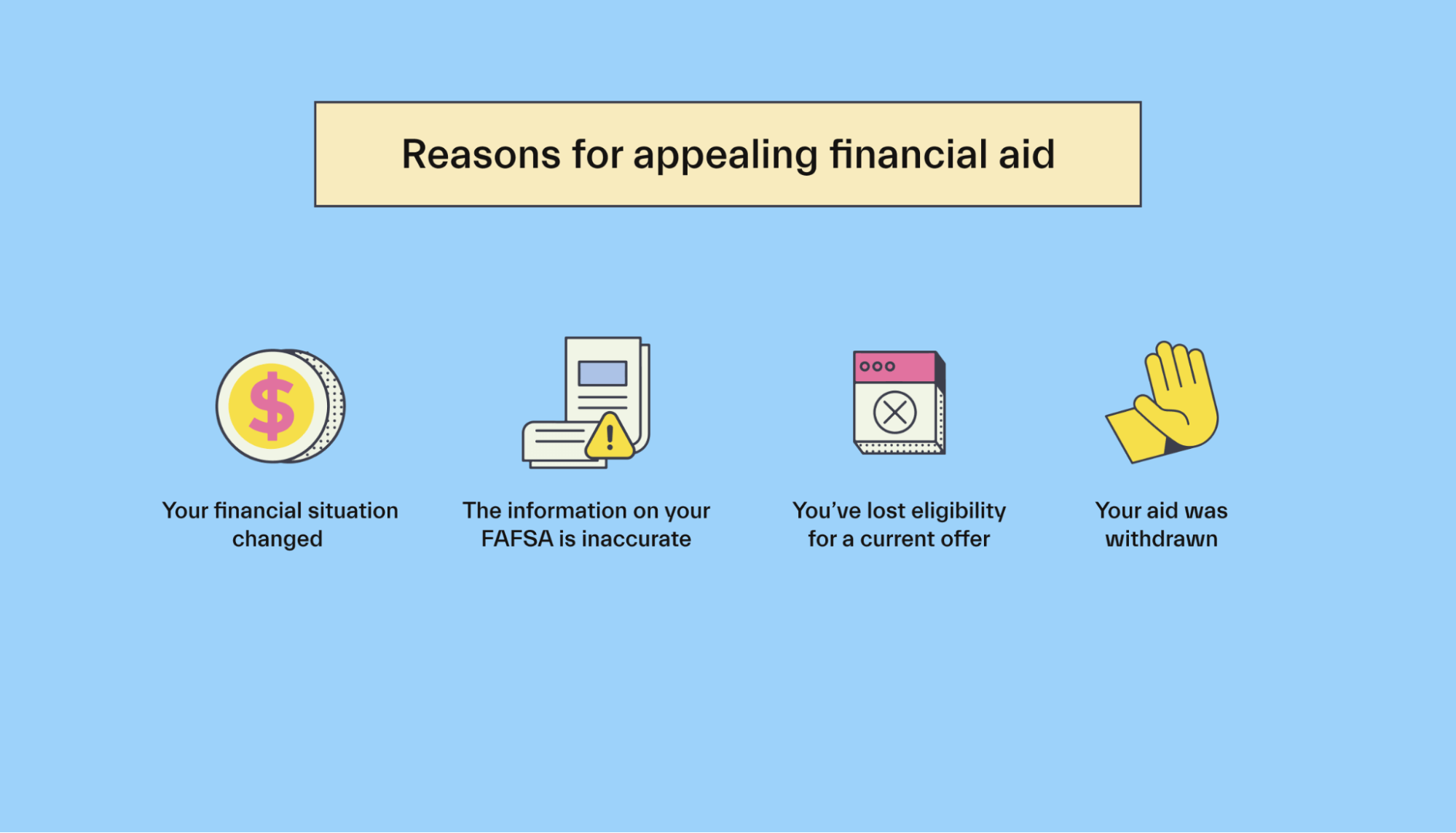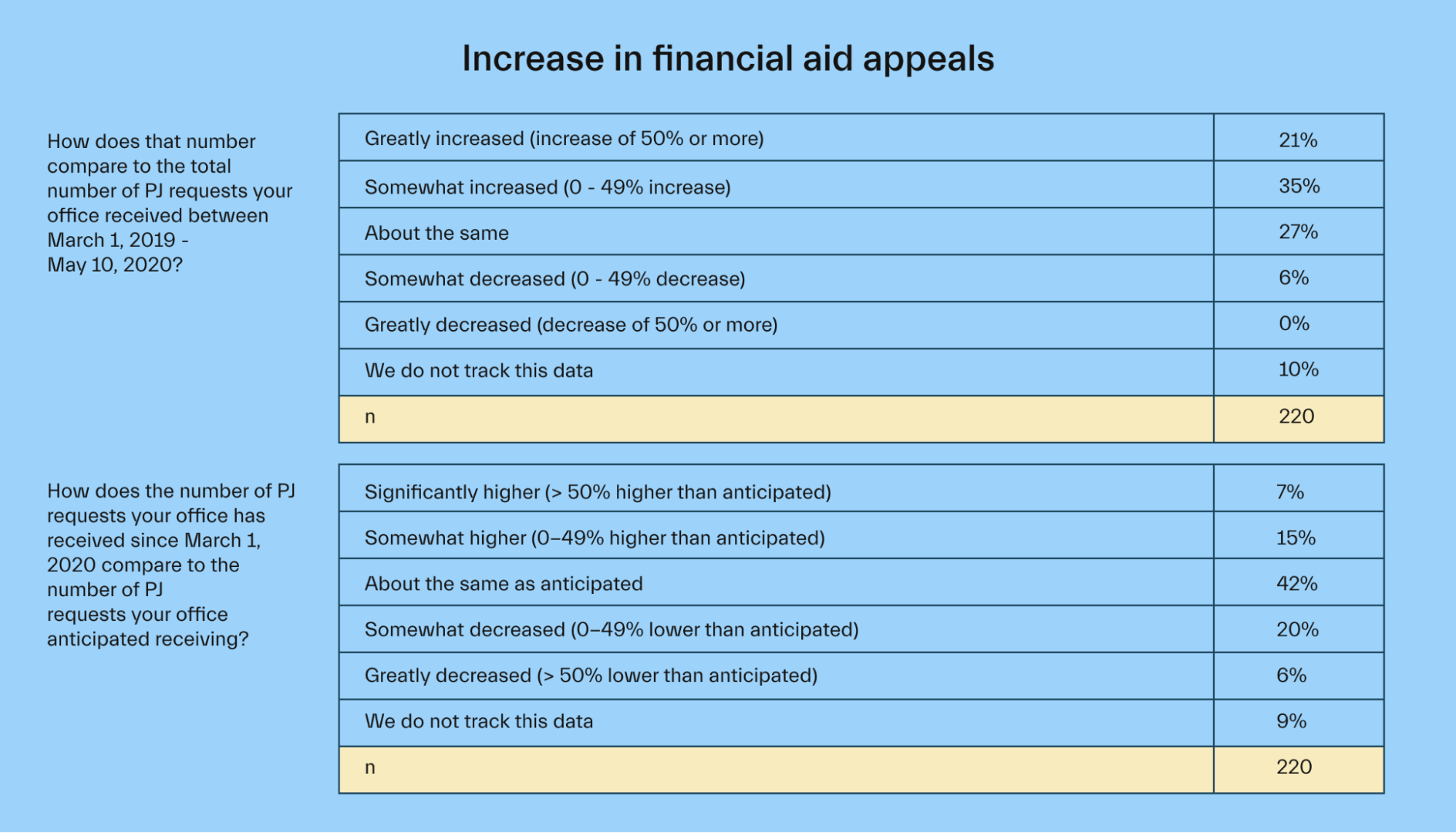How to write a financial need statement for your scholarship application (with examples!)
So you’re applying for a scholarship that asks you about your financial need. What do you say? How honest or specific should you be? What is TMI? In this article, we break down how to pen an awesome financial need scholarship essay or statement.

What to include in a financial need scholarship essay
Template to structure your financial need scholarship essay, introduction: your basic profile, body: your financial situation and hardships, conclusion: how you would benefit from this scholarship, was this financial need essay for a college financial aid application , now, reuse that same essay to apply for more scholarships, additional resources to help you write your financial need scholarship essay.

Many scholarships and college financial aid awards are “need-based,” given to students whose financial situation requires additional support. That’s why one of the most common college scholarship essays is a statement of financial need. This might be very explicit (“Explain your financial need”), somewhat explicit (“Describe your financial situation”), or quite open-ended (“Explain why you need this scholarship”).
In all cases, scholarship providers want to get a sense of your family’s financial picture: what your family income is, if you personally contribute to it (do you have a job?), and how much additional money you need to attend your target college (your “financial gap”).
If the essay prompt is a bit more open-ended (“Explain how this scholarship would help you”), your essay should probably be a combination of a financial need statement and a career goals / academic goals essay. That’s because you want to show how the award will help you financially and in your academic or career goals.
Usually this statement of financial need is a pretty short scholarship essay (150-300 words), so unlike a college essay or personal statement where you have ample word count to tell anecdotes, you’ll likely need to get right to the point.
Be sure to include:
- If you are an underrepresented group at college, for instance, part of an ethnic minority or the first in your family to go to college
- Any relevant family circumstances, like if your parents are immigrants or refugees, as well as your parents’ occupation and how many children/family members they support financially
- How you are currently paying for college, including what you personally are doing to contribute financially (like working student jobs)
- What financial challenges/difficulties your family is facing, for instance, if a parent recently lost their job
- How you would benefit from the scholarship–including your academic and career goals (if word count allows)
Also remember to write in an optimistic tone. Writing about your financial situation or hardships might not be the most positive thing to share. But you can turn it around with an optimistic tone by writing about how these challenges have taught you resiliency and grit.

Give a short introduction to who you are, highlighting any family characteristics that might make you part of an underrepresented group at college.
“I am a first-generation American and the first in my family to go to college. My family moved from El Salvador to New York when I was seven years old, to escape the violence there.”
Example 2:
“I am from a working-class family in Minnesota. My family never had a lot, but we pooled our efforts together to make ends meet. My parents both worked full-time (my father as a mechanic, my mother as a receptionist at the local gym), while my siblings and I all worked weekend jobs to contribute to the family income.”
Dive into the details. How are you currently planning to pay for college? The idea here is to show that you and your family have made a good-faith effort to earn enough money to pay your tuition, but that it has simply not been enough.
Make sure you describe your parents’ occupation, any savings (like a 529 College Savings Account), and any student jobs. You might also discuss any sudden changes in fortune (e.g. parent fell ill or lost their job) that have ruined your original financial plans.
Example
As immigrants with limited English, my parents have had to accept low-paying jobs. My father is an Uber driver, and my mother is a housekeeper. They earn just enough to pay our rent and put food on the table, so I’ve always known they could not help me pay for college. So I’ve been proactive about earning and saving my own money. Since age 11, I’ve worked odd jobs (like mowing my neighbors’ lawns). At age 16, I started working at the mall after school and on weekends. Through all these jobs, I’ve saved about $3000. But even with my financial aid grants, I need to pay $8000 more per year to go to college.
Bring it home by wrapping up your story. Explain how you plan to use the financial aid if you’re awarded this scholarship. How will you benefit from this award? What will you put the money toward, and how will it help you achieve your academic and/or career goals?
Scholarship review boards want to know that their money will be put to good use, supporting a student who has clear plans for the future, and the motivation and determination to make those plans a reality. This is like a shortened, one-paragraph version of the “Why do you deserve this scholarship?” essay .
Winning $5000 would help me close the financial gap and take less in student loans. This is particularly important for me because I plan to study social work and eventually work in a role to support my community. However, since these jobs are not well paid, repaying significant student loans would be difficult. Your scholarship would allow me to continue down this path, to eventually support my community, without incurring debt I can’t afford.
My plan is to study human biology at UC San Diego, where I have been admitted, and eventually pursue a career as a Nurse-Practitioner. I know that being pre-med will be a real academic challenge, and this scholarship would help me focus on those tough classes, rather than worrying about how to pay for them. The $2000 award would be equivalent to about 150 hours of working at a student job. That’s 150 hours I can instead focus on studying, graduating, and achieving my goals.
Sometimes this financial need statement isn’t for an external scholarship. Instead, it’s for your college financial aid office.
In that case, you’re usually writing this statement for one of two reasons:
- You’re writing an appeal letter , to request additional financial aid, after your original financial aid offer wasn’t enough. In this case, you’ll want to make sure you’re being extra specific about your finances.
- You’re applying for a specific endowed scholarship that considers financial need. In this case, your financial need essay can be quite similar to what we’ve outlined above.
Now that you’ve written a killer financial need scholarship essay, you have one of the most common scholarship essays ready on hand, to submit to other scholarships too.
You can sign up for a free Going Merry account today to get a personalized list of hundreds of scholarships matched to your profile. You can even save essays (like this one!) to reuse in more than one application.

You might also be interested in these other blog posts related to essay writing:
- What’s the right scholarship essay format and structure?
- How to write a winning scholarship essay about your academic goals
- How to write an awesome essay about your career goals
- Recent Posts
- Scholarships for Students in Pennsylvania for 2021 - November 11, 2020
- Counselor Starter Guide: How to Use Going Merry’s Scholarship Platform - September 9, 2020
- How to write a financial need statement for your scholarship application (with examples!) - August 13, 2020
Ready to find scholarships that are a match for you?
What are your chances of acceptance?
Calculate for all schools, your chance of acceptance.
Your chancing factors
Extracurriculars.
How to Write a Personal Statement for a Scholarship + Examples
What’s covered:, what is the purpose of the scholarship personal statement, what to include in your personal statement, personal statement example: breakdown + analysis, how to make sure your writing is effective.
Either before or after you’ve gotten into your dream school, you’ll have to figure out how to pay for it. For most students, this involves a combination of financial aid, parent contributions, self-contributions, student loans, and scholarships/grants. Because scholarships are money out of someone else’s pocket that you never have to pay back, they are a great place to start!
Scholarships come in two forms: merit-based and need-based. Need-based scholarships are also often called grants. These designations tell you whether an organization looks at your financial situation when deciding about your scholarship.
Additionally, different scholarships fall under different categories based on the mission of the organization or person providing the scholarship’s financing. These missions typically emphasize different things like academic achievement, specific career goals, community service, leadership, family background, skill in the arts, or having overcome hardship. As you select scholarships to apply for and complete your applications, you should keep these missions in mind.
No matter what type of scholarship you are applying for, you will be asked to provide the review committee with standard materials. This includes your transcript, GPA, and resume/extracurriculars, but also, importantly, your personal statement. A scholarship personal statement is a bit different from your normal college essay, so we’ve put together this guide and some examples to help you get started!
The purpose of your personal statement is to help a review committee learn more about your personality, values, goals, and what makes you special. Ultimately, like with your college essays, you are trying to humanize your profile beyond your transcript, GPA, and test scores.
College essays all have one goal in mind (which is why you can apply to multiple schools at once through applications like the Common App or Coalition App): convince admissions officers that you would be a valuable addition to the university environment. The goal of your scholarship personal statement is different and differs more from one scholarship to the next. Rather than convincing various review committees that you are a generally good candidate for extra funding for college, you need to convince each review committee that your values have historically aligned with their organization’s mission and will continue to align with their organization’s mission.
Common missions amongst those who give scholarships include:
- Providing opportunities for students with career ambitions in a particular field
- Helping students who have experienced unexpected hardship
- Supporting students who show outstanding academic achievement
- Funding the arts through investing in young artists with strong technical skill
- Supporting the development of civic-minded community service leaders of the future
- Providing opportunities for historically underrepresented ethnic communities
If a specific mission like this is outlined on an organization’s website or in the promotional material for its scholarship, the purpose of your personal statement is to show how you exemplify that mission.
Some scholarships ask for your personal statement to be guided by a prompt, while others leave things open for interpretation. When you are provided a prompt, it is obvious what you must do: answer the prompt. When you are not provided a prompt, you want to write a personal statement that is essentially a small-scale autobiography where you position yourself as a good investment. In either case, you should identify a focus or theme for what you are trying to say about yourself so that your application does not get lost in the shuffle.
Prompts include questions like:
- Why do you deserve this scholarship?
- How have you shown your commitment to (leadership/community service/diversity) in your community?
- When did you overcome adversity?
- Why is attending college important to you?
If you are provided a prompt, develop a theme for your response that showcases both your values and your achievements. This will help your essay feel focused and will subsequently help the review committee to remember which candidate you were as they deliberate.
Themes include things like:
- I deserve this community service scholarship because my compassion for intergenerational trauma has inspired me to volunteer with a local after-school program. I didn’t just sympathize. I did something about my sympathy because that’s the type of person I am. Within the program, I have identified avenues for improvement and worked alongside full-time staff to develop new strategies for increasing attendance.
- I overcame adversity when my mother had to have a major surgery two months after giving birth to my younger brother. I was just a kid but was thrown into a situation where I had to raise another kid. It was hard, but I’m the kind of person who tries to grow from hard times and, through my experience taking care of a baby, I learned the importance of listening to body language and nonverbal cues to understand the needs of others (baby and nonbaby, alike).
Without a prompt, clarity can be harder to achieve. That said, it is of the utmost importance that you find a focus. First, think about both your goals and your values.
Types of goals include:
- Career goals
- Goals for personal growth
- The type of friend you want to be
- The change you want to make in the world
Values could include:
- Authenticity
- And many more!
After you write out your goals/values, write out your achievements to see what goals/values you have “proof” of your commitment to. Your essay will ultimately be an exploration of your goal/value, what you have done about your goal/value in the past, and what you aspire to in the future.
You might be tempted to reflect on areas for improvement, but scholarships care about you living out your values. It is not enough to aspire to be exemplary in leadership, community service, or your academic field. For scholarships, you have to already be exemplary.
Finally, keep in mind that the review committee likely already has a copy of your extracurricular activities and involvement. Pick one or two accomplishments, then strive for depth, not breadth as you explore them.
My interest in the field of neuroscience began at a young age. When I was twelve years old, my sister developed a condition called Pseudotumor Cerebri following multiple concussions during a basketball game. It took the doctors over six months to make a proper diagnosis, followed by three years of treatment before she recovered. During this time, my love for neuroscience was sparked as I began to research her condition and, then, other neurocognitive conditions. Later, my love of neuroscience was amplified when my mother began to suffer from brain-related health issues. My mother had been a practicing attorney in Dallas for over twenty years. She was a determined litigator who relentlessly tried difficult cases that changed people’s lives. Now, she suffers from a cognitive impairment and is no longer able to practice law. Oftentimes, she has headaches, she gets “cloudy,” her executive functioning slows down, she feels overwhelmed, and she forgets things. My mother has gone from being the strong, confident, emotional and financial caretaker of our family to needing significant help on a daily basis. Once again, with this illness came a lot of research on my part — research that encouraged me to pursue my dreams of exploring neuroscience.
Due to my experiences with my mother and sister when I was in middle school, I knew that I wanted to make a difference in the field of neuroscience. I also knew that, to obtain this goal, I needed to maintain superior grades in school while also pursuing opportunities outside of school to further my education. In school, I was able to maintain superior grades to the point where I am currently valedictorian in a class of 567 students. In addition, in school, I challenged myself by taking 16 Advanced Placement classes and 19 Honors classes. Two of the most beneficial classes were AP Capstone Seminar and AP Capstone Research. AP Capstone Seminar and AP Capstone Research are research-oriented classes where students are given the opportunity to pursue whatever track their research takes them down. As a junior in AP Capstone Seminar, I researched the effects of harmful pesticide use on the prevalence of Autism Spectrum Disorder (ASD) in children. This year, as a senior in AP Capstone Research, I am learning about the effects of medical marijuana on the treatment of Multiple Sclerosis (MS).
Outside of school, I furthered my education through taking advantage of the Duke TiP summer program. Duke TiP is a summer program run by Duke University where students who score extremely well on the SAT as middle schoolers are able to take college classes at different universities throughout the summers of their middle school and high school years. I took advantage of this opportunity twice. First, I went to Trinity University in San Antonio to expand my horizons and learn more about debate. However, once I was done exploring, I decided I wanted to go into neuroscience. This led me to take an Abnormal Psychology class at Duke University’s West Campus. This class opened my eyes to the interaction between neuroscience and mental health, mental illness, and personality. Years later, I am currently continuing my education outside of school as an intern at the University of Texas Dallas Center for Brain Health. Through this internship, I have been able to see different aspects of neuroscience including brain pattern testing, virtual reality therapy, and longitudinal research studies. With this background, I have positioned myself to be accepted by top neuroscience programs throughout the nation. So far, I have been accepted to the neuroscience department of University of Southern California, the University of Virginia, the University of Texas, and Southern Methodist University, as well as the chemistry department at University of North Carolina–Chapel Hill.
It is with this passion for neuroscience driven by my family and passion for education driven by internal motivation that I will set out to conquer my career objectives. My educational aspirations consist of acquiring a bachelor’s degree in a biological or health science that would assist me in pursuing a medical career as a neuroscience researcher. I decided to attain a career as a researcher since my passion has always been assisting others and trying to improve their quality of life. After obtaining my Masters and my PhD, I plan to become a professor at a prestigious university and continue performing lab research on cognitive disorders. I am particularly interested in disorders such as Autism Spectrum Disorder (ASD). In the lab, I hope to find different therapies and medications to help treat the 3.5 million people around the world suffering from ASD. Furthermore, I want to contribute back to underserved populations that struggle because they do not have as much access to medical assistance as other privileged groups. As such, I hope to do a part of my research in less developed or developing Spanish-speaking countries. This will also allow me to pursue my love of Spanish while pursuing my love of neuroscience. I think that following such a career path will provide me the opportunity to learn about the medical needs of the autistic community and improve their quality of health. Furthermore, I hope to train a new generation of students to strive to research and make comparable discoveries. Whether it be through virtual reality labs or new drug discoveries, I believe that research leads to innovation which leads to a brighter future.
This student does a great job of making themself appear competent and dedicated to the field of neuroscience. This is primarily because they provided tangible evidence of how they have pursued their dedication in the past—through their AP Capstone courses, their Abnormal Psychology class at Duke TiP, and their internship at UTD. There is no doubt in the mind of a reader that this student is high-achieving.
This student also engages successfully with a past-future trajectory, where they end with a vision of how they will continue to use neuroscience in the future. This helps the review committee see what they are investing in and the ways that their money will go to good use.
This student has two major areas for improvement. As we have said, the purpose of a personal statement is for a student to humanize themself to a review committee. This student struggles to depict themself separately from their academic achievements. A solution to this would be for the student to establish a theme towards the beginning of their essay that relates to both their values as a human and their achievements.
At the beginning of the essay, the student explores how their interest in neuroscience began. They explain their interest through the following sentences: “During this time, my love for neuroscience was sparked as I began to research her condition and, then, other neurocognitive conditions” and “Once again, with this illness came a lot of research on my part — research that encouraged me to pursue my dreams of exploring neuroscience.” The student made the great decision to tell the backstory of their interest, but they described their research in very mundane and redundant terms. Instead, they could have focused on their value of intellectual curiosity as a magnetic force that encouraged them to research their mother and sister’s ailments. Curiosity, then, could serve as a value-related thematic throughline to taking AP Capstone classes, taking college courses during the summer that weren’t required, and interning before even graduating high school.
A second area for improvement would be avoiding statistics. As the student identifies their valedictorian status and the number of AP classes they have taken, they might turn away certain personalities on a review committee by appearing braggy. Even further, these statistics are a waste of space. The review committee already has access to this information. These words distract from the major theme of the essay and would have been better used to humanize the student.
Throughout my academic career, I have been an avid scholar, constantly pushing myself towards ambitious goals. I held and continue to hold myself to a high standard, enrolling myself in rigorous curriculum, including Honors and Advanced Placement courses to stretch my mental potential. During my junior year of high school, I took four AP tests, two on the same day, and earned the AP Scholar with Honor Award. Additionally, I received the Letter of Commendation for the PSAT/NMSQT, and qualified for Rotary Top 100 Students both my freshman and senior year, a sign of my commitment to my studies. However, school has not been all about having the best GPA for me; beyond the numbers, I have a deep drive to learn which motivates me to do well academically. I truly enjoy learning new things, whether it be a new essay style or a math theorem. I always give each class my best effort and try my hardest on every assignment. My teachers have noticed this as well, and I have received school Lancer Awards and Student of the Month recognitions as a result. It is a major goal of mine to continue to aspire towards a high level of achievement regarding future educational and occupational endeavors; I plan on continuing this level of dedication throughout my educational career and implementing the skills I have learned and will learn into my college experience and beyond.
This fall, I will begin attending the University of California Los Angeles as an English major. I chose this major because I am fascinated by written language, especially its ability to convey powerful messages and emotions. I also enjoy delving into the works of other authors to analyze specific components of their writing to discover the meaning behind their words. In particular, I cannot wait to begin in-depth literary criticism and learn new stylistic techniques to add more depth to my writing. Furthermore, I recently went to UCLA’s Bruin Day, an event for incoming freshmen, where I was exposed to many different extracurriculars, some of which really piqued my interest. I plan on joining the Writing Success Program, where I can help students receive free writing help, and Mock Trial, where I can debate issues with peers in front of a real judge. The latter, combined with a strong writing background from my undergraduate English studies will be extremely beneficial because I plan to apply to law school after my undergraduate degree. As of now, my career goal is to become a civil rights lawyer, to stand up for those who are discriminated against and protect minority groups to proliferate equality.
As a lawyer, I wish to utilize legislation to ameliorate the plight of the millions of Americans who feel prejudice and help them receive equity in the workplace, society, and so on. Though this seems a daunting task, I feel that my work ethic and past experience will give me the jumpstart I need to establish myself as a successful lawyer and give a voice to those who are often unheard in today’s legal system. I have been a Girl Scout for over a decade and continually participate in community service for the homeless, elderly, veterans, and more. My most recent project was the Gold Award, which I conducted in the Fullerton School District. I facilitated over ten workshops where junior high students taught elementary pupils STEM principles such as density and aerodynamics via creative activities like building aluminum boats and paper airplanes. I also work at Kumon, a tutoring center, where I teach students to advance their academic success. I love my job, and helping students from local schools reach their potential fills me with much pride.
Both being a Girl Scout and working at Kumon have inspired me to help those in need, contributing significantly to my desire to become a lawyer and aid others. My extracurriculars have allowed me to gain a new perspective on both learning and teaching, and have solidified my will to help the less fortunate. In college, I hope to continue to gain knowledge and further develop my leadership skills, amassing qualities that will help me assist others. I plan to join multiple community service clubs, such as UCLA’s local outreach programs that directly aid residents of Los Angeles. I want to help my fellow pupils as well, and plan on volunteering at peer tutoring and peer editing programs on campus. After college, during my career, I want to use legal tactics to assist the underdog and take a chance on those who are often overlooked for opportunities. I wish to represent those that are scared to seek out help or cannot afford it. Rather than battling conflict with additional conflict, I want to implement peaceful but strong, efficient tactics that will help make my state, country, and eventually the world more welcoming to people of all ethnic and socioeconomic backgrounds. These goals are close to my heart and therefore I will be as diligent as I am passionate about them. My perseverance and love for learning and community service drive my ambition in both education and life as a whole, and the drive to make the world a better place is one that I will carry with me for my entire life.
This student emphasizes two values in this essay: hard work and community service. These are values that go together nicely, and definitely make sense with this student’s end goal of becoming a civil rights lawyer! That said, some changes could be made to the way the student presents their values that would make their personal statement more convincing and engaging.
Structurally, instead of using a past-future trajectory, this student starts by explaining their academic achievements, then explains their career goals, then explains their history of community service, then explains their future desires for community service. This structure loses the reader. Instead, the student should have started with either the past or the future.
This could look like 1) identifying their career goals, 2) explaining that hard work and a commitment to community service are necessary to get there, and 3) explaining that they aren’t worried because of their past commitment to hard work and community service. Or it could look like 1) providing examples of their hard work and community service in the past, then 2) explaining how those values will help them achieve their career goals.
Additionally, like with our other example, this student shows a heavy investment in statistics and spouting off accomplishments. This can be unappealing. Unfortunately, even when the student recognizes that they are doing this, writing “beyond the numbers, I have a deep drive to learn which motivates me to do well academically. I truly enjoy learning new things, whether it be a new essay style or a math theorem,” they continue on to cite their achievements, writing “My teachers have noticed this as well, and I have received school Lancer Awards and Student of the Month recognitions as a result.” They say they are going beyond the numbers, but they don’t go beyond the awards. They don’t look inward. One way to fix this would be to make community service the theme around which the essay operates, supplementing with statistics in ways that advance the image of the student as dedicated to community service.
Finally, this student would be more successful if they varied their sentence structure. While a small-scale autobiography can be good, if organized, every sentence should not begin with ‘I.’ The essay still needs to be engaging or the review committee might stop reading.
Feedback is ultimately any writer’s best source of improvement! To get your personal statement edited for free, use our Peer Review Essay Tool . With this tool, other students can tell you if your scholarship essay is effective and help you improve your essay so that you can have the best chances of gaining those extra funds!
Related CollegeVine Blog Posts

Financial Need Essay: Examples & Writing Guide
Unfortunately, not everyone striving for education can afford it. Some courses are so expensive that even well-to-do citizens need financial assistance. They can write a scholarship application letter or refuse the undertaking. In such a case, students are supposed to submit a financial need essay.
Our specialists will write a custom essay specially for you!
Funding authorities cannot assist each student. That is why you need to assure them in your statement of financial need that you deserve the scholarship more than anyone else. This article by Custom-Writing experts provides you with a clear structure. Besides, you will see an accurate statement of financial need essay sample.

- ✅ What to Include
- 🚫 Mistakes to Avoid
- 👀 Essay Sample
🔗 References
✅ statement of financial need: what to include.
This type of writing is a statement of a student’s life circumstances . But there is a limited number of aspects that you need to include. Otherwise, the committee will reject your request for financial aid as it will not look persuasive enough. Follow the next five steps to write a scholarship-winning essay. If you will still be unsure of how to write this kind of paper, explore the example in the next section.
- Introduce yourself. Your readers learn about you for the first time. It is polite to tell them who you are . Stress that you are the first person in your family who will attend a college. If you pertain to an ethnic group that may be underrepresented at the college, mention it.
- Explain how you’re now paying for college. Are you working to pay for your studies? Does this work take the time you could spend learning?
- Justify your financial need. Explain why you need assistance and the difficulties you meet in paying for your studies.
- Describe how you would benefit from the scholarship. Will you have to drop out if you are not given the scholarship? What will happen when you receive it? Explain that you will be able to study more if there is no need to work after classes.
- Make a closing statement . Do not beg and avoid being too emotional. Your essay should sound professional. Thank your readers for taking the time to consider your request.
Here, you can read about other secrets of scholarship essay writing .
🚫 Financial Need Essay: Mistakes to Avoid
There are several big mistakes that students can make in their scholarship essays.
👀 Statement of Financial Need: Essay Sample
We hope that this short, but comprehensive guide will get your essay going! Good luck and be sure to check out our blog for more writing tips.
Just in 1 hour! We will write you a plagiarism-free paper in hardly more than 1 hour
✏️ Financial Need Essay FAQ
There is no universal way to justify why you need money. Every situation is unique. Every person might have their life circumstances. Typically, students apply for scholarships because they can’t work full-time yet. Thus, they cannot afford the desired program.
Two key strategies to ask for scholarship money are those below.
1. Write an impressive motivation letter mentioning your tight budget,
2. Write an application letter describing your tough life circumstances (especially if you have incomplete family, etc.).
For additional details, check examples of such papers online and in books.
Applying for a scholarship implies proving why you deserve this assistance. Demonstrate your strong motivation, your real passion for learning, describe your educational background. If you want to be chosen for the program, take a look at examples and templates available online. You need to highlight your strengths and motivation .
It’s probably a bad idea to begin with the statement of financial need itself. Instead, demonstrate your strong motivation and even passion first. Briefly describe your background and highlight relevant educational and work experience. Acknowledge that financial assistance would help you to develop further.
- Writing a Winning College Scholarship Essay | The Princeton Review
- 5 Ways to Make Your Scholarship Essay Stand Out – U.S. News
- How to Write a Scholarship Essay – Maryville University Online
- How Aid Is Calculated | Federal Student Aid
- Definition of need | Student Financial Aid | University of Missouri
- How need is determined | Student Financial Aid (UWashington)
- Share to Facebook
- Share to Twitter
- Share to LinkedIn
- Share to email
![personal statement financial hardship Quieting Your Inner Critic – Self-Compassion and Other Methods [Guide for Students]](https://custom-writing.org/blog/wp-content/uploads/2024/03/side-view-woman-looking-up-1-284x153.jpg)
Have you ever found yourself stuck in a cycle of self-doubt and criticism, constantly feeling as though you’re not good enough? Since social rejection poses a genuine threat to our existence, our self-criticism steps in to protect us by shaming us before others can. It makes us feel inadequate to...

Have you ever wondered how your brain processes information? Or why we remember some things and not others? Welcome to the fascinating world of information processing theory. By delving into this theory, you can uncover the intricate mechanisms of the human brain and unlock the secrets to maximizing your cognitive...

Disclaimer: Since we are true proponents of experiential learning, our introduction starts with an example, and the theory will come later. Pretty much everyone likes a chamomile plant. If you are one of the few who don’t, feel free to think of any other plant while you consider these two...

Do you ever find yourself procrastinating, struggling to stay motivated and pursue your goals? If so, you’re not alone. In fact, what we know as laziness, it is often a fear of failure, the pressure of high expectations, or a simple need for relaxation. These issues are so common today...

Academic probation is a period of academic evaluation where a student’s performance falls below the expected educational standard. Going through academic probation is not the apocalypse, even though it may initially feel like it. Academic probation serves as a wake-up call, prompting us to reevaluate our approach to studying and...

Did you know that top smartphone manufacturers continue to make those seemingly outdated push-button cell phones? They’re often dubbed ‘granny phones.’ While we strive to combat ageism in society, it persists. Individuals in their later years often resist changing their customary practices. But does our brain truly diminish with age,...

Learning styles are one of the most debatable concepts in American education. They represent a pillar that supports the educational industry. Moreover: Many teachers and caregivers believe that learning styles are inborn and define how successful the child will be in their future career and personal life. What’s the use...

Non scholae sed vitae discimus – We don’t learn for school, but for life While for some people, lifelong learning is a buzzword from yet another New York Times bestseller, for others, it is a lifestyle. Learning throughout life means continuously seeking knowledge and expanding your horizons, regardless of your...

You might think it’s impossible to invest as a student. When we’re young, we have lots of time and not much money. As we get older, we often have more money and responsibilities and less time. But thanks to modern technologies, investing in 2024 is multifaceted and more accessible. You...

Students in today’s classrooms reflect a vibrant tapestry of ethnic backgrounds and cultural identities. It’s no surprise: in recent years, racial diversity in US public schools has increased dramatically. According to research led by the National Center for Education Statistics, more than half of all students are representatives of ethnic...
![personal statement financial hardship How to Organize a Successful Study Group [GUIDE]](https://custom-writing.org/blog/wp-content/uploads/2023/04/doing-homework-together-1-284x153.jpg)
Are you looking for effective ways to retain information? If so, you’re not alone. In fact, many students find that traditional learning methods, such as lectures and textbooks, aren’t enough to help them actually remember new facts and concepts. But did you know that discussing topics and teaching others can...

Wise people say that living without a goal is like running a race without a finish line. No matter how hard you try, your journey leads you nowhere, and your immediate successes don’t give you a sense of accomplishment. This type of lifestyle can be frustrating, especially because paying the...
Thank you for the financial need essay writing tips you have posted. They are very helpful! I’ll return to this blog for more useful guidelines for writing papers!
Ha, fully posting! How to ask for money? Yeah, it is a great idea to write a financial need essay in a humorous manner.
- PRO Courses Guides New Tech Help Pro Expert Videos About wikiHow Pro Upgrade Sign In
- EDIT Edit this Article
- EXPLORE Tech Help Pro About Us Random Article Quizzes Request a New Article Community Dashboard This Or That Game Popular Categories Arts and Entertainment Artwork Books Movies Computers and Electronics Computers Phone Skills Technology Hacks Health Men's Health Mental Health Women's Health Relationships Dating Love Relationship Issues Hobbies and Crafts Crafts Drawing Games Education & Communication Communication Skills Personal Development Studying Personal Care and Style Fashion Hair Care Personal Hygiene Youth Personal Care School Stuff Dating All Categories Arts and Entertainment Finance and Business Home and Garden Relationship Quizzes Cars & Other Vehicles Food and Entertaining Personal Care and Style Sports and Fitness Computers and Electronics Health Pets and Animals Travel Education & Communication Hobbies and Crafts Philosophy and Religion Work World Family Life Holidays and Traditions Relationships Youth
- Browse Articles
- Learn Something New
- Quizzes Hot
- This Or That Game New
- Train Your Brain
- Explore More
- Support wikiHow
- About wikiHow
- Log in / Sign up
- Education and Communications
- College University and Postgraduate
- Student Finances
How to Write a Financial Aid Statement
Last Updated: February 1, 2023 Fact Checked
This article was co-authored by Michael R. Lewis . Michael R. Lewis is a retired corporate executive, entrepreneur, and investment advisor in Texas. He has over 40 years of experience in business and finance, including as a Vice President for Blue Cross Blue Shield of Texas. He has a BBA in Industrial Management from the University of Texas at Austin. This article has been fact-checked, ensuring the accuracy of any cited facts and confirming the authority of its sources. This article has been viewed 555,687 times.
The financial aid statement is a simple, short piece of writing that students may include on a financial aid letter, in an essay, or in other communications to a financial aid department. The financial aid statement may not be a full communication on its own, but rather an element of a more complex financial aid appeal. If you need to write such a statement in order to reach out to a university or college's financial aid office, follow some basic steps.
Sample Statements and Things to Include

Writing a Statement of Financial Need

- For example, you could write the following: “My parents moved to the United States from Albania in order to give us better opportunities. As their oldest child, I will be the first in our family to attend college.”

- For example, write something like this: “I have worked to help support my family since I was 16 years old. Currently, I work on the weekends as a waitress to support myself. My parents also give me what they can each month. Since my parents didn’t speak English when we moved here, it was very difficult for them to support our family. My mother worked many hours as a housekeeper in a hotel. They saved what they could, but we do not have enough savings to pay for my college education."

- For example: “My earnings from my weekend job cover my living expenses. I worked extra shifts over the summer and saved enough to pay for a portion of this year’s tuition. However, I am seeking aid for the portion of the tuition I cannot cover on my own.”

- For example: “Receiving financial aid will allow me to focus on my studies during the week without having to worry about earning extra money. I would continue to work on the weekends to cover my living expenses, but I would be able to keep the weekdays free to focus solely on my school work.”

- For example: “Thank you for considering my application. I look forward to discussing my opportunities with you.”
Writing a Statement for a Scholarship

- For example: “I am applying for this scholarship in order to further my studies in education. My long-term goal is to work as an ESL teacher in an inner city environment. My academic, work and personal experiences have lead me to this career goal.”

- For example: “I graduated from my undergraduate institution with a 4.0 GPA. I had a double major of Elementary Education and Spanish, with a minor in Sociology. I applied for and received a prestigious internship working with the state government on developing educational policies.”

- For example: “My parents moved our family to this country from Albania when I was 12 years old. I did not speak any English when we arrived. The ESL teachers in my school helped me to be successful in school, and I want to do the same for other students in my circumstances.”

- For example: “Each summer, I volunteer for the Migrant Workers Education Association in Chester County, Pennsylvania. They service migrant workers who come here from Mexico to work on mushroom farms. We not only link families with community services, but we also tutor children in English and help them learn important school skills that will allow them to be successful in school.”

- For example: “My experiences as an ESL student and an English tutor have taught me the value of helping children to feel successful and empowered. I know the meaning of hard work, and I have learned how to overcome challenges in my own personal and academic life.”

Making Your Personal Statement Successful

Expert Q&A
You might also like.

- ↑ http://www.bestvalueschools.com/faq/what-is-a-statement-of-financial-need/
- ↑ https://www.goingmerry.com/blog/how-to-write-a-scholarship-essay-or-statement-about-your-financial-need-with-examples/
- ↑ https://www.laguardia.edu/uploadedfiles/main_site/content/supporters_friends/docs/scholarship_personal_statement.pdf
- ↑ https://scholarships360.org/financial-aid/how-to-write-a-statement-of-financial-need/
- ↑ https://custom-writing.org/blog/financial-needs-essay
- ↑ http://financialaid.ucdavis.edu/scholarships/tips/personal.html
About This Article

If you’re writing a statement of financial need, make it personal by sharing information about yourself and what's motivating you to pursue your studies. Try to be authentic, to write honestly about what you've already accomplished and what you hope to do with your education. Use specific examples if you can to reinforce the points you're trying to make. Finally, be sure to start your first draft early enough to get feedback from teachers or advisers and make revisions before you submit it. For more advice from our reviewer, including how to write a statement for a scholarship, keep reading! Did this summary help you? Yes No
- Send fan mail to authors
Reader Success Stories
Feb 6, 2017
Did this article help you?
Zarina Tokhtaeva
Apr 5, 2016
Mar 9, 2017
Mar 29, 2017
Mar 22, 2019

Featured Articles

Trending Articles

Watch Articles

- Terms of Use
- Privacy Policy
- Do Not Sell or Share My Info
- Not Selling Info
Don’t miss out! Sign up for
wikiHow’s newsletter
Scholarship Essays

Describe Your Financial Need for this Scholarship Essay Sample
Briefly describe your financial need for this scholarship.
I am in need of financial assistance in order to attend college because I am a low-income student. I am the 1st child to attend the college. Although my parents gave me many supports, I received a limited financial assistance due to low family income. To reduce family burden, I took out student loans to pay for my tuitions. Meanwhile, I am working 19 hours per week on campus to support myself. However, with the increasing tuitions this year, I am facing more challenges on financial need. As a senior in Petroleum Engineering, I wish to spend more time on my major courses because these courses are cores of my major and crucial in my future career. Unfortunately, financial burden may lessen my time on mastering the courses. Therefore, I would greatly appreciate a helping hand so that I can successfully obtain my engineering degree.
Awarding this scholarship will make great contribution to my study in Louisiana State University. This scholarship would allow me to work less and focus more on my studies. Meanwhile, this scholarship will support me to do more on community service and explore my potential in assisting the needs of people. Furthermore, receiving this scholarship will give me more opportunities to attend the conference and expose to newly developed technology. Additionally, awarding this scholarship would further motivate me to pursue academic excellence
Original Source: Essay Forum
Financial aid •
January 4, 2023
Sample letter of extenuating circumstances for financial aid
Our guide to writing a sample letter of extenuating circumstances for financial aid.

Jessica Ancajas
Financial Aid Analyst

There aren’t many students out there who can afford to pay for college without financial aid. In fact, a whopping 86% of college students rely on some form of financial aid to support them through college.
Regardless, these grants, scholarships, and loan opportunities simply aren’t enough to help students bridge that financial gap.
Want some good news? If you’re not offered enough financial aid to pursue your studies, you can usually make an appeal.
By launching an appeal for more financial aid, you might convince the financial aid office at your school to reexamine your circumstances—and potentially offer you extra cash as a result.
This appeals process normally starts by writing a letter of extenuating circumstances.
This guide explains when you should appeal for more financial aid and what to include in a letter of extenuating circumstances. We’ll also walk you through a sample letter of extenuating circumstances so you know exactly how to craft yours.

8 reasons for appealing financial aid
Believe it or not, the teams that manage most financial aid offices at US colleges are pretty understanding and willing to listen. If you genuinely need a higher amount of financial aid to afford school, it’s possible to get help.
However, you can’t just call up your school’s financial aid office and beg for another scholarship because you’ve blown your tuition money on spring break.
If you want to successfully appeal your financial aid offer, you need to have a good reason—and although each student has their own unique economic situation, there are 4 main reasons you may want to consider launching a financial aid appeal .

1. Your financial situation changed
The first reason you might find yourself in a situation in which you’re going to want to appeal your financial aid offer is that your financial situation has changed.
The scope for this appeal strategy is pretty broad—meaning that there can be many different types of changes that could impact your ability to pay for school.
For example, perhaps your mom has lost her job, or she’s had to take a new job that pays much lower than her previous one—and she’s the sole source of income for your family.
Let’s say you’ve included her old salary information as part of your Free Application for Federal Student Aid (FAFSA) . That means your financial aid office has come up with an aid offer based on outdated information.
Because your parent is now earning way less money, you may now qualify for a higher grant or a different scholarship award because your financial need has increased.
The same rule applies to an extenuating circumstance like an unexpected healthcare issue that you’ve had to pay for out-of-pocket. It can also apply to dental expenses that are not covered by insurance.
Likewise, if your parents have recently divorced, it’s possible this big family change has had a negative impact on the amount of money you’ve got to pay for school.
These are all situations that finance teams generally listen to with a lot of empathy, and they could lead to a new assessment of how much aid you’ve been offered.
2. The information on your FAFSA is inaccurate
The second reason you may need to launch a financial aid appeal is that the income you listed on your FAFSA simply isn’t accurate.

This inaccuracy could boil down to a drastic change in your personal finances (which we’ve already covered). But your FAFSA could also be wrong because you accidentally made a simple error.
For example, maybe your FAFSA didn’t allow you enough space to fully demonstrate how a large portion of your family income is needed to cover existing debts—or you might have just filled in the wrong number in the wrong box.
Don’t stress—accidents happen. You just need to clearly explain the problem and be able to provide accurate information to fix the mistake.
3. You’ve lost eligibility for a current offer
The third reason you might launch a financial aid appeal is that you've lost eligibility for an existing offer. A lot of colleges offer scholarships or grants based on the requirement that you have a certain GPA throughout your time at the school.
But if you’ve experienced a dramatic life event that impacted your grades and your financial aid was revoked, you might be able to launch a successful financial appeal.
Examples include pregnancy, a new illness, bereavement, or ending up homeless.
In some cases, your school will consider these events and overturn your loss of financial aid on compassionate grounds.
In order to qualify, you’ll need to file a Satisfactory Academic Progress (SAP) appeal.

4. Your aid was withdrawn
The fourth reason schools will often consider your financial aid appeal is because your existing aid has been withdrawn.
For example, perhaps you’ve been awarded a grant by your school, but the grant scheme gets pulled before you’re able to get the full amount you were originally expecting.
You should be able to appeal this loss of income—and, hopefully, get matched with a replacement grant or scholarship.
No matter your reason, the bottom line is this: if you haven’t been offered decent enough financial support to pay for your tuition, it’s always worth appealing. After all, those who don’t ask don’t get.
5. The size of your family has changed
If your family grows or shrinks through the birth or adoption of a child or the death of a parent or guardian, you should reach out to your school to let them know. A large portion of your family’s expected family contribution to the cost of college can be impacted by your household size, so a change could make you eligible for more aid.
It is helpful to have documentation showing how and when your household size changed, so have adoption paperwork, a death certificate, or other supporting evidence handy when you submit this request.
6. A natural disaster or another emergency has impacted your family
If your family lives in an area impacted by a natural disaster, such as a hurricane or major flood, you should communicate this to your financial aid office. This event likely had a major impact on your family’s financial situation, and, depending on the damage, it could have affected your living situation as well.

You might be able to get additional aid from your school, as well as more flexibility when it comes to things like move-in and move-out dates for your dormitory or other forms of assistance.
Some schools also have financial support available to people who are dealing with the fallout from the Covid-19 pandemic, so if your family has been impacted by that, let your financial aid office know.
7. You have a new or newly diagnosed medical condition
If you’ve been diagnosed with a medical or mental health condition, you may be eligible for additional financial aid. Depending on the nature of the condition, you might also want to reach out to your school’s disability resource center for additional support with things like taking notes or handling assignments.
When you send your letter of extenuating circumstances to your financial aid office, provide details about your condition and how it impacts your need for financial aid. Have medical documentation—preferably on official letterhead—from a healthcare provider to show the school.
8. You have a sibling in an elementary or secondary school that charges tuition
The federal government specifically notes that paying private elementary and secondary school tuition is a special circumstance that could impact your financial need and reduce your expected family contribution to the cost of college.
If you have a sibling or family member attending a private elementary or secondary school, let your financial aid office know after you submit the FAFSA. Provide supporting documentation to show how much the tuition costs. Some colleges may treat these expenses as a reduction in income and increase your need-based financial aid accordingly.
What is a letter of extenuating circumstances for financial aid?
The COVID-19 pandemic has impacted some family incomes over the past couple of years. As a result, colleges are currently accepting more financial aid appeals than ever before.
According to a new survey from the National Association of Student Financial Aid Administrators (NASFAA), more than half of colleges reported an increase in the number of “professional judgment requests” in 2020.
A professional judgment request is just a fancy way of describing a third-party reexamination of a student’s FAFSA offer.

But it’s one thing to convince a university to reexamine your financial aid offer. Actually securing a better financial aid package is a whole different ball game.
That’s why any successful financial aid appeal must begin with a well-written and organized letter of extenuating circumstances.
A letter of extenuating circumstances sounds complicated, but it’s really just an official request for help.
The letter needs to clearly explain the problem and the current status of your financial award .
Then, it needs to demonstrate why your existing financial aid offer simply isn’t enough to support your studies.

Before you sit down and write a letter of extenuating circumstances for financial aid, you should get in touch with your financial aid office. They’ll be able to tell you who to send the letter to and if it should be delivered virtually or physically.
You should also ask your financial aid office if the school has a particular appeals process and if there’s anything in particular you need to know before appealing for more aid.
For example, your college might have a specific appeal form you’ll need to complete and submit alongside your letter of extenuating circumstances.
It’s also important to note that you’ll normally be expected to submit any supporting documentation relevant to your letter. Always provide evidence to support your appeal.
What to include in a letter of extenuating circumstances for financial aid
If you’ve never made an appeal for extra financial aid, it can be a little bit daunting trying to write a letter of extenuating circumstances for the first time.
To help you get started, we’ll take a look at all of the stuff you should include in your letter.

A personal address
Most financial aid offices will have an appointed team member responsible for handling financial aid appeals. Address your letter to that person—not “to whom it may concern.”
By addressing your letter to that individual in particular, you’ll demonstrate that you’ve done your research, understand the school’s protocol, and you’re taking this matter seriously.
A specific reason
Remember: your college wants to help you. But if you don’t explain exactly why you need more cash to pay for college , they probably won’t consider your appeal. You must be specific.
A letter of extenuating circumstances is your place to explain why you’re asking for help.
Detail what’s happened with your parent’s career, describe ongoing medical conditions, or discuss any other specific reason you’re finding it hard to pay for college.
Documentation
Your appeal probably won’t be considered if you can’t provide proof of your financial need.
After explaining the specific reason you require extra aid, you should include all of the appropriate documentation alongside your letter to prove your claims are true.
For example, if you’ve had an unexpected medical emergency that’s drained your life savings, a hospital invoice or letter from your health insurance company will be able to demonstrate the story in your letter is real.
A specific request
Your letter will be a lot more effective if you request a specific amount of money.

After explaining your financial problem, include some basic math and show the person reading exactly how much money you need to make up the difference. This could be to pay for tuition, travel costs, housing, or anything in between.
Explain what you can’t afford and how much more you need.
Likewise, a letter of extenuating circumstances is also a good place to outline any competing offers of financial aid you might have from other schools. If one college has offered you a bigger scholarship than another, write to your other schools asking them to match it.
Questions about the next steps
You should always close your letter by asking for details about the next step in the appeals process.
Ideally, you’ll already have contacted your school’s financial aid office to figure out what those steps are, but by asking about the next step in your letter, you’re prompting the recipient to write you a response.
Above all else, your letter should be polite and show how thankful you are that you were offered anything at all.
Remember: your letter is a request for help. Nobody is going to want to help you if you write them an angry letter ranting about how unfair life is or how greedy you think the school looks.
By showing a bit of humility in your letter, the person reading it’ll be more inclined to show you kindness in return.

Sample letter of extenuating circumstances for financial aid
If you need a hand getting started writing a financial aid appeal letter, don’t worry.
Here’s an example of a sample letter of extenuating circumstances for financial aid we’ve written that you can use as a template:
Dear Ms. Xxxxxxx,
I am an incoming freshman student planning to attend the University of College in the fall.
I would like to thank you for the financial aid package the university has offered. Unfortunately, my family’s financial situation has changed significantly since submitting my FAFSA.
Prior to receiving my financial award letter, my father developed a chronic illness and has had to reduce his work hours dramatically. Meanwhile, our family is now facing significant medical bills of approximately $20,000.
Bearing in mind my father earned over half of our household income, our family no longer has sufficient funds to cover the cost of outstanding tuition and living expenses. We are now currently facing a shortfall of $5,750 per semester.
I sincerely want to continue with my plans to study at the University of College this fall. That is why I am requesting the university review my award in relation to my change in financial circumstances.
Enclosed, you will find supporting documentation, including my father’s medical diagnosis, payslips demonstrating his reduced hours, and evidence of monthly medical expenses. I have also attached a completed copy of the University of College’s financial aid appeal form.
If you have any questions or require any additional information about this appeal, please don’t hesitate to get in touch. Thank you in advance for reviewing my appeal.
College Student
Student number: 123456789

At the end of the day, those who don’t ask don’t get.
If you or your family have experienced serious financial difficulties, it’s always worth appealing to your school for more financial aid—and the best way to make it happen is by submitting a letter of extenuating circumstances to your college’s finance office.
When it comes to writing your letter, there are plenty of sample letters out there, so try not to stress. Take your time, be sincere, and don’t be afraid to ask for help writing your letter or collating supporting documentation to help your appeal.
Join Mos now, and we can match you with loads of scholarships and other financial aid opportunities to help you make the most of your time in college!
To learn more about college financial aid, check out our article Financial Aid FAQs .
Let's get
- Get paired with a financial aid expert
- Get more money for school
- Get more time to do you

More reads for you

Financial aid FAQs
Updated October 28, 2022

What's financial aid?

How to make money in college
Budgeting •
Updated April 7, 2023
Official websites use .gov A .gov website belongs to an official government organization in the United States.
Secure .gov websites use HTTPS A lock ( A locked padlock ) or https:// means you've safely connected to the .gov website. Share sensitive information only on official, secure websites.
- Create Account
Chapter 5 - Extreme Hardship Considerations and Factors
A. totality of the circumstances.
The officer must make extreme hardship determinations based on the factors, arguments, and evidence submitted. [1] Therefore, the officer should consider any submission from the applicant bearing on the extreme hardship determination. The officer may also consider factors, arguments, and evidence relevant to the extreme hardship determination that the applicant has not specifically presented, such as those addressed in Department of State (DOS) information on country conditions [2] or other U.S. Government determinations regarding country conditions, including a country’s designation for Temporary Protected Status (TPS). Officers must base their decisions on the totality of the evidence and circumstances presented.
B. Common Consequences
The common consequences of denying admission, in and of themselves, do not warrant a finding of extreme hardship. [3] The Board of Immigration Appeals (BIA) has held that the common consequences of denying admission include, but are not limited to, the following:
Family separation;
Economic detriment;
Difficulties of readjusting to life in the new country;
The quality and availability of educational opportunities abroad;
Inferior quality of medical services and facilities; and
Ability to pursue a chosen employment abroad.
While extreme hardship must involve more than the common consequences of denying admission, the extreme hardship standard is not as high as the significantly more burdensome “exceptional and extremely unusual” hardship standard that that applies to other forms of immigration adjudications, such as cancellation of removal. [4]
C. Factors Must Be Considered Cumulatively
The officer must consider all factors and consequences in their totality and cumulatively when assessing whether a qualifying relative will experience extreme hardship either in the United States or abroad. In some cases, common consequences that on their own do not constitute extreme hardship may result in extreme hardship when assessed cumulatively with other factors. [5]
For example, if a qualifying relative has a medical condition that alone does not rise to the level of extreme hardship, the combination of that hardship and the common consequences of inferior medical services, economic detriment, or readjusting to life in another country may cumulatively cause extreme emotional or financial hardship for the qualifying relative when considering the totality of the circumstances.
Ordinarily, for example, the fact that medical services are less comprehensive in another country is a common consequence of denying admission; but the inferior quality of medical services, considered along with the individual’s specific medical conditions, may create sufficient difficulties as to rise to the level of extreme hardship in combination with all the other consequences.
The officer must weigh all factors individually and cumulatively, as follows:
First, the officer must consider whether any factor set forth individually rises to the level of extreme hardship under the totality of the circumstances.
Second, if any factor alone does not rise to the level of extreme hardship, the officer must consider all factors together to determine whether they cumulatively rise to the level of extreme hardship. This includes hardships to multiple qualifying relatives.
When considering the factors, whether individually or cumulatively, all factors, including negative factors, must be evaluated in the totality of the circumstances.
D. Examples of Factors that May Support a Finding of Extreme Hardship
The chart below lists factors that an applicant might present and that would be relevant to determining whether an applicant has demonstrated extreme hardship to a qualifying relative. This list is not exhaustive; circumstances that are not on this list may also be relevant to finding extreme hardship.
The presence of one or more of the factors below in a particular case does not mean that extreme hardship would necessarily result from a denial of admission. But they are factors that may be encountered and should be considered in their totality and cumulatively in individual cases. All hardship factors presented by the applicant should be considered in the totality of the circumstances in making the extreme hardship determination.
Some of the factors listed below apply when the qualifying relative would remain in the United States without the applicant. Other factors apply when the qualifying relative would relocate abroad. Some of the factors might apply under either circumstance.
E. Particularly Significant Factors
The preceding list identifies factors that may bear on whether a denial of admission would result in extreme hardship. Below are factors that USCIS has determined often weigh heavily in support of finding extreme hardship. An applicant who seeks to demonstrate the presence of one of the enumerated circumstances must submit sufficient reliable evidence to support the existence of such circumstance(s) and show that the circumstance will cause extreme hardship to the qualifying relative. The mere presence of an enumerated circumstance does not create a presumption of extreme hardship. The ultimate determination of extreme hardship must be based on the totality of the circumstances present in the individual case.
It is important to emphasize that the enumerated circumstances listed below are specifically highlighted only because they are often likely to support findings of extreme hardship. Other hardships not enumerated may also rise to the level of extreme, even if they vary significantly than those listed below. [10]
Eligibility for an immigration benefit ordinarily must exist at the time of filing and at the time of adjudication. [11] However, considering the nature of the particularly significant factors described below, the presence of one or more of these circumstances at the time of adjudication should be considered by a USCIS officer even if the circumstance arose after the filing of the waiver request.
1. Qualifying Relative Previously Granted Iraqi or Afghan Special Immigrant Status, T Nonimmigrant Status, or Asylum or Refugee Status
If a qualifying relative was previously granted Iraqi or Afghan special immigrant status, [12] T nonimmigrant status, asylum status, or refugee status in the United States from the country of relocation and the qualifying relative’s status has not been revoked, those factors would often weigh heavily in support of finding extreme hardship. [13] The existence of this circumstance normally results in hardship greater than the common consequences denying admission, whether in cases involving relocation or separation.
The prior decision to grant the qualifying relative status as an Iraqi or Afghan special immigrant, T nonimmigrant, refugee, or asylee indicates the significantly heightened risk that relocation to the country from which he or she received protection could result in retaliatory violence, persecution or other danger to the qualifying relative. This prior assessment by USCIS would often weigh heavily in support of finding extreme hardship in a case involving relocation.
The same is also true in cases involving separation. The prior assessment by USCIS with respect to the qualifying relative indicates that he or she would likely face increased difficulty returning to that country to visit the applicant, thus generally resulting in hardship that is greater than that normally present in cases involving family separation. The applicant might also show that, due to their relationship, the applicant may experience persecution or other dangers similar to those that gave rise to the qualifying relative’s underlying status. The qualifying relative in such a case may suffer additional psychological trauma due to the potential for harm to the applicant in the country of relocation.
2. Qualifying Relative or Related Family Member’s Disability
Cases involving disabled individuals often involve hardships that rise above the common consequences. If a government agency has made a formal disability determination [14] with regard to the qualifying relative, or with regard to a family member of the qualifying relative who is dependent on the qualifying relative for care, that factor would often weigh heavily in support of finding that either relocation or separation would result in extreme hardship under the totality of the circumstances.
In cases involving either (1) relocation of the qualifying relative with a disability or (2) relocation of both the qualifying relative and the relevant family member with a disability, the applicant will need to show that the services available to the disabled individual in the country of relocation are unavailable or significantly inferior to those available to him or her in the United States. In such cases, the disability determination would often weigh heavily in support of a finding of extreme hardship.
In cases involving separation, the applicant will need to show that the qualifying relative with a disability, or the relevant family member with a disability, generally requires the applicant’s assistance for care due to the disability. Where replacement care is not realistically available and obtainable, the disability determination would often weigh heavily in support of a finding of extreme hardship.
Absent a formal disability determination, an applicant may provide other evidence that a qualifying relative or relevant individual suffers from a medical condition, whether mental or physical, that makes either travel to, or residence in, the country of relocation detrimental to the qualifying relative or family member’s health or safety. Similarly, an applicant may provide other evidence that the condition of the qualifying relative requires the applicant’s assistance for care.
3. Qualifying Relative’s Military Service
Military service by a qualifying relative often results in hardships from denial of the applicant’s admission that rise above the common consequences of denying admission. If a qualifying relative is an Active Duty member of any branch of the U.S. armed forces, [15] or is an individual in the Selected Reserve of the Ready Reserve, denial of an applicant’s admission often causes psychological and emotional harm that significantly exacerbates the stresses, anxieties and other hardships inherent in military service by a qualifying relative.
This may result in an impairment of the qualifying relative’s ability to serve the U.S. military, or to be quickly called into active duty in the case of reservists, which also affects military preparedness. This is often the case even if the qualifying relative’s military service already separates, or will separate, him or her from the applicant. In such circumstances, the applicant’s removal abroad may magnify the stress of military service to a level that would constitute extreme hardship.
4. DOS Travel Warnings
DOS issues travel warnings to notify travelers of the risks of traveling to certain foreign countries. [16] Reasons for issuing travel warnings include, but are not limited to, unstable government, civil war, ongoing intense crime or violence, or frequent terrorist attacks. A travel warning remains in place until changes in circumstances sufficiently mitigate the need for such a warning. With respect to some travel warnings, DOS advises of travel risks to a specific region or regions of the country at issue.
In some situations, DOS issues travel warnings that do more than notify travelers of the risks of traveling to a particular country or region(s) within a country. Rather, DOS affirmatively recommends against travel or affirmatively recommends that U.S. citizens depart. DOS may make such travel warnings country-wide. Such travel warnings may contain language in which:
DOS urges avoiding all travel to the country or region because of safety and security concerns;
DOS warns against all but essential travel to the country or region;
DOS advises deferring all non-essential travel to the country or region; and/or
DOS advises U.S. citizens currently in the country or region to depart.
In cases where a qualifying relative would relocate to a country or region that is the subject of such DOS recommendations against travel, the travel warning would often weigh heavily in support of a finding of extreme hardship. In assessing the dangers in the country of relocation, USCIS officers should give weight to DOS travel warnings, taking into account the nature and severity of such warnings.
Generally, the fact that the country of relocation is currently subject to a DOS country-wide travel warning against travel may indicate that a qualifying relative would face significantly increased danger if he or she were to relocate to that country with the applicant. This significantly increased danger would often support a finding of extreme hardship.
If the relevant travel warning covers only a part or region of the country of relocation, the USCIS officer must determine whether the qualifying relative would relocate to the part or region that is subject to the warning. If the officer finds that this part or region is one to which the qualifying relative plans to return despite the increased danger (for example, because of family relationships or employment opportunities), that may indicate that the qualifying relative would face significantly increased danger if he or she were to relocate to that part or region. This significantly increased danger would often support a finding of extreme hardship.
Alternatively, if the officer finds that the qualifying relative would relocate to a part of the country that is not subject to the travel warning (because of the danger in the part or region covered by the travel warning or for any other reason), that indicates that the qualifying relative would generally not face significantly increased danger upon relocation.
If the officer finds that the qualifying relative would remain in the United States while the applicant returns to a country or region that is subject to a DOS warning against travel, the officer should evaluate whether the separation may result in extreme hardship to the qualifying relative. In such cases, the officer should consider the hardship to the qualifying relative resulting from the increased danger to the applicant in the relevant country or region.
5. Substantial Displacement of Care of Applicant’s Children
USCIS recognizes the importance of family unity and the ability of parents and other caregivers to provide for the well-being of children. [17] Depending on the particular facts of a case, either the continuation of one’s existing caregiving duties under new and difficult circumstances or the need to assume someone else’s caregiving duties can be sufficiently burdensome to rise to the level of extreme hardship. The children do not need to be U.S. citizens or lawful permanent residents (LPRs) in such cases. [18]
In cases involving the separation of spouses in which the qualifying relative is the primary caretaker and the applicant is the primary income earner, the income earner’s refusal of admission often causes economic loss to the caregiver. Although economic loss alone is generally a common consequence of a denial of admission, depending on the particular circumstances the economic loss associated with the denial of admission may create burdens on the caregiver that are severe enough to rise to the level of extreme hardship. That can occur, for example, when the qualifying relative must take on the additional burdens of primary income earner while remaining the primary caregiver. That dual responsibility may significantly disrupt the qualifying relative’s ability to meet his or her own basic subsistence needs or those of the person(s) for whom the care is being provided. In such cases, the dual burden would often support a finding of extreme hardship. In addition, the qualifying relative may suffer significant emotional and psychological impacts from being the sole caregiver of the child(ren) that exceed the common consequences of being left as a sole parent.
In cases involving the separation of spouses in which the qualifying relative is the primary income earner and the applicant is the primary caretaker, the caretaker’s refusal of admission can result in a substantial shift of caregiving responsibility from the applicant to the qualifying relative. Such a shift may significantly affect the qualifying relative’s ability to earn income for the family; disrupt family, social, and cultural ties; or hinder the child(ren)’s psychological, cognitive, or emotional development.
The shift may also frustrate or complicate the qualifying relative’s efforts to provide a healthy, stable, and caring environment for the child(ren). Such additional emotional, psychological and/or economic stress for the qualifying relative could exceed the levels of hardship that ordinarily result from family separation, and rise to the level of extreme hardship. [19]
Under either scenario discussed above, the significant shifting of caregiving or income-earning responsibilities would often weigh heavily in support a finding of extreme hardship to the qualifying relative, provided the applicant shows:
The existence of a bona fide relationship between the applicant and the child(ren);
The existence of a bona fide relationship between the qualifying relative and the child(ren); and
The substantial shifting of caregiving or income-earning responsibilities under circumstances in which the ability to adequately care for the children would be significantly compromised.
To prove a bona fide relationship to the child(ren), the applicant and qualifying relative should have emotional and/or financial ties or a genuine concern and interest for the child(ren)’s support, instruction, and general welfare. [20] Evidence that can establish such a relationship includes (but is not limited to):
Income tax returns;
Medical or insurance records;
School records;
Correspondence between the parties; or
Affidavits of friends, neighbors, school officials, or other associates knowledgeable about the relationship.
To prove the qualifying relative would take on the additional caregiving or income-earning responsibilities, the applicant needs to show that the qualifying relative either (1) is a parent of the child(ren) in question or (2) otherwise has the bona fide intent to assume those responsibilities. Evidence of such an intent could include (but is not limited to):
Legal custody or guardianship of the child;
Other legal obligation to take over parental responsibilities;
Affidavit signed by qualifying relative to take over parental or other caregiving responsibilities; or
Affidavits of friends, neighbors, school officials, or other associates knowledgeable about the qualifying relative’s relationship with the children or intentions to assume parental or other caregiving responsibilities.
F. Hypothetical Case Examples
Below are hypothetical cases that can help officers determine when cases present factors that rise to the level of extreme hardship. These hypotheticals are not meant to be exhaustive or all-inclusive with respect to the facts or scenarios that may be presented for adjudication and that may give rise to extreme hardship. Although a USCIS officer presented with similar scenarios as those presented in the hypotheticals could reasonably reach the same conclusions described below, extreme hardship determinations are made on a case-by case basis in the totality of the circumstances. An extreme hardship determination will always depend on the facts of each individual case.
For purposes of the following hypotheticals, it is assumed that:
The applicant is inadmissible under a ground that may be waived based on a showing of extreme hardship to a qualifying relative spouse or parent. [21]
The facts asserted in the hypotheticals are supported by appropriate documentation.
Tyler was admitted to the United States as a nonimmigrant 5 years ago. Three years after Tyler’s entry, Tyler married Pat, a U.S. citizen spouse. Tyler seeks a waiver claiming that Pat would suffer extreme hardship if Tyler were denied admission to the United States.
Pat submits a credible, sworn statement indicating that if Tyler is refused admission, Pat would relocate to Tyler’s native country. Tyler and Pat have been married for 2 years. Pat is a sales clerk. A similar job in the country of relocation would pay far less than Pat earns in the United States. In addition, although Pat has visited the country of relocation several times, Pat is not fluent in the country’s language and lacks the ties that would facilitate employment opportunities and social and cultural integration.
Tyler is a skilled laborer who similarly would command a much lower salary in the country of relocation, but who was, prior to coming to the United States, gainfully employed. The couple is renting an apartment in the United States, does not own any real estate or other significant property, and has no children. Pat and Tyler do not have any other family, either in the United States or in the country of relocation.
Analysis of Scenario 1
These facts alone generally would not favor a finding of extreme hardship. The hardships to Pat, even when aggregated, include only common consequences of relocation—economic loss and the social and cultural difficulties arising mainly from Pat ’s inability to speak the language fluently.
The facts are the same as in Scenario 1 except that Pat (who is Tyler’s U.S. citizen spouse and would relocate) has a chronic medical condition requiring regular visits to the doctor, and Tyler is an unskilled worker who would command a much lower salary in the country of relocation. In addition, Pat has family that lives nearby and is a crucial part of Tyler’s support system. Pat and Tyler are also active members of their local community and have friends who often help out when Pat’s family is not available. Based on the care received from the doctor and the support received from family and friends, Pat is able to manage the chronic condition.
Pat submits a credible, sworn statement that Pat will relocate with Tyler despite Pat’s medical condition, and the evidence shows under the totality of the circumstances that Pat will relocate with Tyler. Pat’s doctor provides a statement that confirms that Pat will continue to progress and function well if Pat keeps receiving medical treatment and the support from family and other members of Pat’s existing social support network. While the doctor cannot fully attest to the availability of care in Tyler’s native country, the doctor is able to attest that moving to another country and disrupting Pat ’s medical care and support network will cause Tyler significant difficulties. The doctor’s statement also states that Pat will likely not be able to work without the support system Pat has in the United States.
Analysis of Scenario 2
These facts would generally favor a finding of extreme hardship. The aggregate hardships to Pat now include not only the economic losses, diminution of employment opportunities, and social, cultural, and linguistic difficulties (which are generally common consequences of relocation) but also the additional medical hardship that Pat would experience if Pat relocates to Tyler’s native country. The attestation of Pat’s doctor expressing concerns about the disruption in medical care, the effect of losing support from Pat’s family and social environment, and the possibility of Pat not being able to accept employment, would generally favor a finding of extreme hardship.
Assume the facts are the same as originally presented in Scenario 1 (without the additional facts from Scenario 2), but now with the added facts that Tyler also has LPR parents who live in the United States. Pat submits a credible, sworn statement indicating that Pat would relocate with Tyler and that Tyler’s LPR parents would remain in the United States. Again, when analyzing the additional evidence under the totality of the circumstances, the the evidence shows Pat will still relocate with Tyler.
Tyler and Pat both have a close relationship with Tyler’s parents, who are elderly and non-native English speakers. Tyler regularly transports the parents to medical appointments, translates medical and other instructions, and offers them significant emotional support. As a result of the separation from Tyler and Tyler’s spouse, Tyler’s parents would suffer significant emotional hardship.
Analysis of Scenario 3
Based on the totality of the evidence presented, the addition of these facts would generally favor a finding of extreme hardship. There are now 3 qualifying relatives (Tyler’s U.S. citizen spouse and Tyler’s two LPR parents). Although the aggregated hardships to Tyler’s spouse alone (under Scenario 1) include only common consequences of a refusal of admission, aggregating those hardships with the hardships to Tyler’s elderly parents, which include the potential disruption of their medical care, loss of ability to navigate their surroundings in English, and their significant emotional hardship resulting from the loss of their child’s support, would generally tip the balance in favor of a finding of extreme hardship.
EF has lived continuously in the United States since entering without inspection 4 years ago. She has been married to GH, her U.S. Citizen husband, for 2 years. EF seeks a waiver claiming that GH would suffer extreme hardship if EF were denied admission to the United States. GH has a moderate income, and EF works as a housecleaner for low wages. GH submits a credible, sworn statement that he would remain in the United States, and thus would separate from EF, if she is denied the waiver. Upon separating, the couple would lose the income EF earns. In addition to losing EF’s income, GH is committed to sending remittances to EF once she leaves, in whatever amount GH can afford. EF and GH do not have children, and GH does not have family in the United States.
Analysis of Scenario 4
These facts alone generally would not rise to the level of extreme hardship, even if the hardships to the qualifying relative are aggregated. The hardships to GH do not rise above the common consequences of separation and economic loss.
JK has lived continuously in the United States since entering without inspection 6 years ago. She married LM, her U.S. citizen husband, 2 years ago. JK seeks a waiver on the basis that LM would suffer extreme hardship if JK were denied admission to the United States. JK and LM live near LM’s family and friends, and LM has spent little time traveling abroad. He does not speak the language of the country to which JK would return if she is denied admission, and LM’s employment opportunities in that country would be less desirable than in the United States.
Additionally, DOS has issued a travel warning that strongly advises against travel to specific regions in the country to which JK would return, including the region where her family lives. The region-specific warning affirmatively recommends against non-essential travel to that region, citing the high rate of kidnapping and murder. LM submits a credible, sworn statement indicating that due to his recent marriage, the difficulties JK would face in her country, and his commitment to supporting her however possible, he would relocate to remain with JK if she is denied a waiver.
Analysis of Scenario 5
The totality of these circumstances generally would favor a finding of extreme hardship, significantly in light of the nature and severity of the DOS travel warning. Although the other hardships present in the case are common consequences of relocation, LM has also demonstrated that he will return to the region of a country that is the subject of the DOS travel warning, which advises against non-essential travel to that region. The travel warning recommending against travel to that particular region of that country to which LM would relocate is a particularly significant factor that would often weigh heavily in support of a finding of extreme hardship. If the travel warning were less severe or only temporary, the warning would not qualify as a particularly significant factor but would be another factor to be considered in the totality of the circumstances by the officer.
Alternatively, in some circumstances where DOS has issued travel warnings with regard to a particular region of a country, the applicant and qualifying relative may relocate to a different region of the country that is not subject to a travel warning. In such a situation, the fact of the region-specific travel warning would not itself constitute a particularly significant factor; however, the hardships arising from relocating to another region of the country remains a factor to be considered and may result in a finding of extreme hardship, based on the totality of the circumstances. [22]
OP has lived continuously in the United States since entering without inspection 7 years ago. After dating and living together for 5 years, OP married her same-sex partner SQ, a U.S. citizen. OP seeks a waiver claiming that SQ would suffer extreme hardship if OP were denied admission to the United States. SQ submits a credible, sworn statement indicating that she would remain in the United States and separate from OP if the waiver is denied.
SQ owns a business in the United States, and OP has continuously supported the business, including by helping out as an office manager. SQ would not be able to keep the business running successfully without OP because of the expense of hiring an office manager. In addition, the DOS country report indicates that women in OP’s country of relocation generally may not work outside the home except in an extremely limited set of professions (such as teaching) for which OP is not qualified.
The country report also indicates that same-sex marriages are not recognized in that country, that same-sex sexual conduct is illegal, and that official societal discrimination and harassment (in some circumstances even giving rise to physical threats or harm) based on sexual orientation or gender identity is prevalent in many areas of life.
Based on these factors, SQ fears OP would be discriminated against and potentially be at risk of physical harm based on her sexual orientation. SQ has been in therapy due to depression and anxiety after she learned that her wife may be denied admission to the United States and that her wife would have to remain in a country where she risks discrimination and physical harm. The couple does not provide other evidence of hardship.
Analysis of Scenario 6
These facts would generally favor a finding of extreme hardship. SQ would face serious economic detriment if OP is denied admission. In addition, the country reports show that SQ’s marriage to OP would not be recognized in OP’s native country, and that OP’s marriage to a person of the same gender is a common cause for social ostracism, discrimination, and potential physical danger in OP’s native country. The country reports further show that OP’s access to education, employment and health care could be limited due to OP’s sexual orientation and gender, thereby negatively affecting OP’s subsistence.
SQ would face psychological trauma based on the fear that OP would be harassed or threatened because of her sexual orientation. SQ’s trauma based on her fear that OP will be ostracized and persecuted in OP’s native country based on her sexual orientation and gender are factors that in the totality of circumstances would ordinarily rise to the level of extreme hardship.
TU married his U.S. citizen wife, VW, 3 years ago. TU seeks a waiver on the ground that VW would suffer extreme hardship if TU were denied admission to the United States. Before becoming a U.S. citizen, VW and some members of her family fled persecution from her native country, and they were granted asylum in the United States. TU is of the same nationality. VW submits a credible, sworn statement that she would remain in the United States and separate from TU if the waiver is denied. The evidence also supports the conclusion that the return of TU to that country would cause VW particular anxiety and psychological stress, due both to the limitations on VW’s ability to visit her husband and to the harm TU may face in the country of return due to his relationship to VW.
Analysis of Scenario 7
These facts generally would favor a finding of extreme hardship. TU and VW are of the same nationality, and TU would return to the country from which VW fled. The fact that VW was previously granted asylum from the country of relocation is a particularly significant factor that would often weigh heavily in support of a finding of extreme hardship. The fact that VW and members of her family were previously granted asylum from the country of return shows that she is at risk of persecution if she were to return to that country to even visit her husband.
She has also submitted credible evidence indicating that she would suffer additional anxiety and psychological stress from the harm her husband may face due to his relationship with her and her family. The totality of these circumstances, including the particularly significant factor of VW’s grant of asylum, would generally result in a finding of extreme hardship.
XY married her U.S. citizen husband, ZA, 9 years ago. XY seeks a waiver on the basis that ZA would suffer extreme hardship if XY were denied admission to the United States. XY and ZA have a 3-year old son and a 2-year old daughter. XY submits credible evidence showing that she is the primary caretaker of the children and that ZA is the primary income earner. His wages are not sufficient to pay for childcare and the couple does not have family that can provide childcare for the children.
ZA submits a credible, sworn statement indicating that he will remain in the United States with their children separated from XY if the waiver is denied. The evidence also indicates that XY will have very limited employment opportunities in the country of return because of her limited education. Whatever income XY will be able to earn in the country of return will be spent on her subsistence and will be insufficient to allow her to contribute to childcare or other family needs in the United States. Due to the lack of childcare options available to ZA, he will be required to become the sole caregiver of the children, while simultaneously striving to maintain his role as the family’s sole income earner.
If ZA is unable to retain his job due to the assumption of primary caregiving responsibilities, he will lose the income necessary to support his children. The dual burden of being both the primary income earner and sole caregiver will create significant psychological, emotional, and financial stresses for ZA. Additionally, the evidence shows that the displacement of childcare would impact the emotional state and development of the children, which would require further care and attention on the part of ZA.
Analysis of Scenario 8
These facts would generally favor a finding of extreme hardship. Although ZA’s children are not qualifying relatives for purposes of demonstrating extreme hardship in this case, the hardship to ZA caused by becoming primarily responsible for the children’s care, while maintaining his role as primary income earner, would implicate the particularly significant factor for substantial displacement of care of the applicant’s children.
In this case, ZA and XY submitted credible evidence that XY cannot contribute to the family’s needs, that ZA is unable to earn sufficient income for family needs if he must assume primary caregiving responsibilities, and that ZA otherwise lacks the resources or support network to replace either the primary caregiving responsibilities he would need to assume or the primary income-earning role that has been the source of the family’s support.
The evidence also shows that the displacement of childcare would impact the children in a manner that would require additional care and attention by ZA and would thus further impact ZA’s ability to care for his children. Absent other facts that diminish the impacts of the separation, this scenario would generally rise to the level of extreme hardship based on the totality of the circumstances.
Alternatively, this particularly significant factor may also be presented in a case where the applicant is the primary income earner and the qualifying relative is the primary caretaker of the children. If the applicant is refused admission, the qualifying relative could be required, depending on the circumstances, to take on the additional responsibilities of being the primary income earner in addition to continuing his or her role as primary caretaker.
In cases where this heightened responsibility would threaten the qualifying relative’s ability to meet basic subsistence needs for the family, the significant emotional and psychological stress caused by the added burdens would often weigh heavily in support of a finding of extreme hardship. [23]
[^ 1] See Matter of Cervantes-Gonzalez (PDF) , 22 I&N Dec. 560 (BIA 1999), aff’d, Cervantes-Gonzales v. INS , 244 F.3d 1001 (9th Cir. 2001). See Matter of L-O-G (PDF) - , 21 I&N Dec. 413 (BIA 1996). See Matter of Anderson (PDF) , 16 I&N Dec. 596 (BIA 1978).
[^ 2] See DOS Country Reports on Human Rights Practices and DOS Travel Warnings .
[^ 3] See Matter of Ngai (PDF) , 19 I&N Dec. 245 (BIA 1984) (“Common results of the bar, such as separation, financial difficulties, etc. in themselves are insufficient to warrant approval of an application unless combined with much more extreme impacts").
[^ 4] See INA 240A(b)(1)(D) .
[^ 5] See Matter of O-J-O- (PDF) , 21 I&N Dec. 381, 383 (BIA 1996).
[^ 6] The characteristics for which a person is ostracized or stigmatized may be actual or perceived (that is, the person may actually have that characteristic, or someone may perceive the person as having that characteristic).
[^ 7] The officer should consider any submitted government or nongovernmental reports on country conditions specified in the hardship claim. In the absence of any evidence submitted on country conditions, the officer may refer to DOS information on country conditions, such as DOS Country Reports on Human Rights Practices and the most recent DOS Travel Warnings , to corroborate the claim.
[^ 8] For more information on TPS, see the USCIS website .
[^ 9] See 5 U.S.C. 5928 . See Department of State Danger Pay Regulations, available at Standardized Regulations (DSSR) .
[^ 10] See Section D, Examples of Factors that Might Support Finding of Extreme Hardship [ 9 USCIS-PM B.5(D) ].
[^ 11] See 8 CFR 103.2(b)(1) .
[^ 12] See, for example, Division F, Title VI of the Omnibus Appropriations Act of 2009, Pub. L. 111-8 (PDF) , 123 Stat. 524, 807 (March 11, 2009). See Section 1244 of the National Defense Authorization Act for Fiscal Year 2008, Pub. L. 110-181 (PDF) , 122 Stat. 3, 396 (January 28, 2008). See Section 1059 of the National Defense Authorization Act for Fiscal Year 2006, Pub. L. 109-163 (PDF) , 119 Stat. 3136, 3443 (January 6, 2006), as amended by Pub. L. 110-36 (PDF) , 121 Stat. 227 (June 15, 2007).
[^ 13] Although it is unlikely that a qualifying relative would have been granted withholding of removal under INA 241(b)(3) or withholding or deferral of removal under the Convention Against Torture (CAT), if a qualifying relative was previously granted such a form of relief, this would often weigh heavily in support of a finding of extreme hardship to that qualifying relative, similar to situations involving qualifying relatives described in this particularly significant factor.
[^ 14] Federal agency programs focusing on individuals with disabilities generally rely on definitions found in their authorizing legislation. These definitions may be unique to an agency’s program.
[^ 15] See 10 U.S.C. 101 . The term “armed forces” means the Army, Navy, Air Force, Marine Corps, and Coast Guard.
[^ 16] See DOS Travel Warnings .
[^ 17] The term “child” includes those related to the applicant by birth, adoption, marriage, legal custody, or guardianship.
[^ 18] In this scenario, the children are assumed to be under age 21. See INA 101(b)(1) and INA 101(c)(1) .
[^ 19] These scenarios are not exhaustive. For example, even when a qualifying relative is not the primary caretaker or breadwinner. Nonetheless, the loss of the applicant’s contribution to caretaking or support may have consequences that rise to the level of extreme hardship to the qualifying relative based on the totality of the circumstances.
[^ 20] USCIS applies a similar principle when assessing whether there is a bona fide relationship between a father and his child born out of wedlock. See INA 101(b)(1)(D) and 8 CFR 204.2(d)(2)(iii) .
[^ 21] None of these examples involves a waiver authority where the child is a qualifying relative under the Immigration and Nationality Act (INA). For more on qualifying relatives, see Chapter 4, Qualifying Relative [ 9 USCIS-PM B.4 ].
[^ 22] If the entire country is the subject of a travel warning that affirmatively recommends against travel or residence, the particularly significant factor will exist and would often weigh heavily in support of a finding of extreme hardship. For more on travel warnings, see Section E, Particularly Significant Factors, Subsection 4, DOS Travel Warnings [ 9 USCIS-PM B.5(E)(4) ].
[^ 23] For more on substantial displacement of care, see Section E, Particularly Significant Factors, Subsection 5, Substantial Displacement of Care of Applicant’s Children [ 9 USCIS-PM B.5(E)(5) ].
8 CFR 212.7 - Waiver of certain grounds of inadmissibility
INA 212(a)(9)(B)(v) - Waiver of the 3-year or 10-year unlawful presence bar
INA 212(h)(1)(B) - Waiver for certain criminal and related grounds
INA 212(i) - Admission of immigrant excludable for fraud or willful misrepresentation of material fact
G-28, Notice of Entry of Appearance as Attorney or Accredited Representative
I-601, Application for Waiver of Grounds of Inadmissibility
I-601A, Application for Provisional Unlawful Presence Waiver
How to Use the USCIS Policy Manual Website (PDF, 2.99 MB)
No appendices available at this time.
This technical update replaces all instances of the term “alien” with “noncitizen” or other appropriate terms throughout the Policy Manual where possible, as used to refer to a person who meets the definition provided in INA 101(a)(3) [“any person not a citizen or national of the United States”].
1 USCIS-PM - Volume 1 - General Policies and Procedures
2 USCIS-PM - Volume 2 - Nonimmigrants
6 USCIS-PM - Volume 6 - Immigrants
7 USCIS-PM - Volume 7 - Adjustment of Status
8 USCIS-PM - Volume 8 - Admissibility
9 USCIS-PM - Volume 9 - Waivers and Other Forms of Relief
10 USCIS-PM - Volume 10 - Employment Authorization
11 USCIS-PM - Volume 11 - Travel and Identity Documents
12 USCIS-PM - Volume 12 - Citizenship and Naturalization
U.S. Citizenship and Immigration Services (USCIS) is updating and incorporating relevant Adjudicator’s Field Manual (AFM) content into the USCIS Policy Manual. As that process is ongoing, USCIS has moved any remaining AFM content to its corresponding USCIS Policy Manual Part, in PDF format, until relevant AFM content has been properly incorporated into the USCIS Policy Manual. To the extent that a provision in the USCIS Policy Manual conflicts with remaining AFM content or Policy Memoranda, the updated information in the USCIS Policy Manual prevails. To find remaining AFM content, see the crosswalk (PDF, 317.68 KB) between the AFM and the Policy Manual.
3 USCIS-PM - Volume 3 - Humanitarian Protection and Parole
4 USCIS-PM - Volume 4 - Refugees and Asylees
5 USCIS-PM - Volume 5 - Adoptions
This technical update replaces all instances of the term “foreign national” with “alien” throughout the Policy Manual as used to refer to a person who meets the definition provided in INA 101(a)(3) [“any person not a citizen or national of the United States”].
U.S. Citizenship and Immigration Services (USCIS) is issuing policy guidance on determinations of extreme hardship to qualifying relatives as required by certain statutory waiver provisions. This guidance becomes effective December 5, 2016.
9 USCIS-PM B - Part B - Extreme Hardship
Version History
No historical versions available.

IMAGES
VIDEO
COMMENTS
Example 1: "I am a first-generation American and the first in my family to go to college. My family moved from El Salvador to New York when I was seven years old, to escape the violence there.". Example 2: "I am from a working-class family in Minnesota.
Example 2: "Describe your financial need in 100 words". This essay is even shorter than the financial need statement. It may be one of several short answer questions you need to fill out. Working with 100 words is tricky. That only leaves room for about 7-10 sentences, depending on length.
35 Simple Hardship Letters Templates [Financial, for Mortgage, for Loan Modification] A document that explains your circumstances in a certain situation, a hardship letter usually shows that you're unable to pay debt. To request for special consideration, a person struggling with his or her finances uses a hardship letter known as a financial ...
Hardship Fund Personal statement. I am applying for this hardship fund because I am struggling inancially. This year I have been extremely money cauious and have put copious amounts of stress on myself taking up a bar job in my inal year of study, which is also the most important year.
Personal Statement Example: Breakdown + Analysis. Example 1. My interest in the field of neuroscience began at a young age. When I was twelve years old, my sister developed a condition called Pseudotumor Cerebri following multiple concussions during a basketball game.
Generally, the statement of financial need will go beyond what is captured by the FAFSA or CSS profile. In this article, we will provide a step-by-step guide to show you how to write a statement of financial need. Apply to these scholarships due soon. $10,000 "No Essay" Scholarship. 1 award worth $10,000.
Stay Focused on Goals. Remember that you're seeking a specific outcome from your hardship letter. State the facts and keep your emotions out of it. Your letter should propose your ideal solution ...
1. Write an impressive motivation letter mentioning your tight budget, 2. Write an application letter describing your tough life circumstances (especially if you have incomplete family, etc.). For additional details, check examples of such papers online and in books.
3. Justify why you are seeking aid. Explain the difficulties you are having meeting your needs. Describe changes in your life that have affected your ability to pay for college. For example, changes in your family's income or unexpected expenses may have caused a financial deficit.
Briefly Describe your Financial Need for this Scholarship. I am in need of financial assistance in order to attend college because I am a low-income student. I am the 1st child to attend the college. Although my parents gave me many supports, I received a limited financial assistance due to low family income. To reduce family burden, I took out ...
Situation: Write a brief explanation of your situation and why you're asking for help. Plan of action: Explain what you are requesting from the lender and how you plan to adjust your financial situation so you can continue to make payments in the future. Closing statement: Let the lender know what type of response you are looking for and ...
The average credit card interest rate is over 16%, which means you could be saving big if you consolidated your credit card debt with a 0% APR credit card or a personal loan. Balance transfer ...
A hardship letter template should include the following details: Your full name and address. Name of the lending institution. Account number. Explanation of your situation. An explanation of the steps you have taken to resolve your cash flow/debt issues. What you would like the lender to do to help resolve your issues.
The hardship should not appear vague. Supporting documents should be included to give specific details. To support their claim of financial hardship, the candidate should include their W-2 form or tax return depending on the type of hardship they have. They may also want to include their bank statements for the past six months.
Our guide to writing a sample letter of extenuating circumstances for financial aid. There aren't many students out there who can afford to pay for college without financial aid. In fact, a whopping 86% of college students rely on some form of financial aid to support them through college. Regardless, these grants, scholarships, and loan ...
30 Effective Financial Hardship Letter Templates. March 30, 2021 6 Mins Read. Financial difficulty is a big reality and there are various reasons that might lead you to get entangled in the web of borrowings and loans. No matter the amount of planning, you fail to fulfill your financial obligations. If you find yourself struggling to resolve ...
Usually this statement of financial need is a pretty short scholarship essay (150-300 words), ... You must complete first or and a the below print and provide documentation to support your submit of financial hardship. Form C58P, Personal Financial Statement. Example 2:
The officer must weigh all factors individually and cumulatively, as follows: First, the officer must consider whether any factor set forth individually rises to the level of extreme hardship under the totality of the circumstances. Second, if any factor alone does not rise to the level of extreme hardship, the officer must consider all factors ...
Personal Statement Tip: Dealing with Hardship. A friend of mine was recently going through a hard time. Things were going wrong, seriously wrong in her life. She wryly labeled these experiences "character building." It is a sad truth that tragedy and trial build character strength and develop wisdom.
What the U.S. government recognizes as "extreme hardship" for waiver purposes, and how to prove it when applying for a U.S. visa or green card. If you are attempting to get a visa or green card in the U.S., but are blocked because you match one of the grounds of inadmissibility found in U.S. immigration law (mostly crimes, immigration ...
Submit your Financial Status Report online. By mail: Fill out and sign VA Form 5655. Write your personal statement in a separate document. Get VA Form 5655 to download Mail your form and statement to: U.S. Department of Veterans Affairs Debt Management Center PO Box 11930 St. Paul, MN 55111.
Updated October 11, 2023. A personal financial statement is a document summarizing a person's financial standing. It provides a full list of their personal assets and liabilities as well as their income and expenses. Commonly required by financial institutions when applying for credit or a loan, it demonstrates a person's creditworthiness and repayment ability.
To submit a VA personal statement, complete VA Form 21-4138, Statement in Support of Claim. If you are submitting a VA lay witness or buddy statement, you'll need to submit VA Form 21-10210 . The VA personal statement Form 21-4138 asks for basic information like name, social security number, date of birth, telephone number, and address.